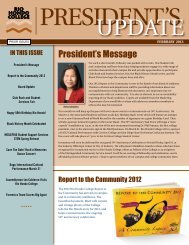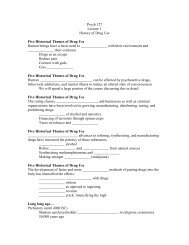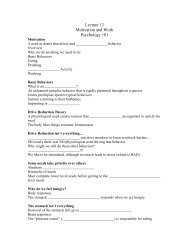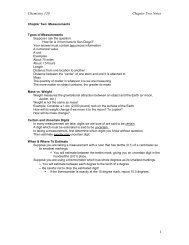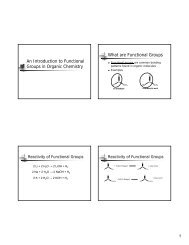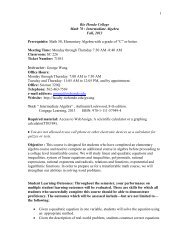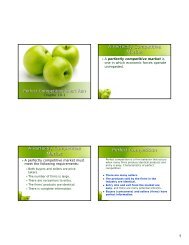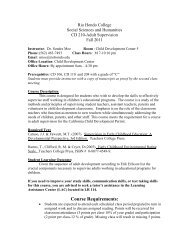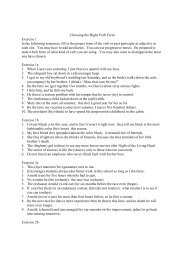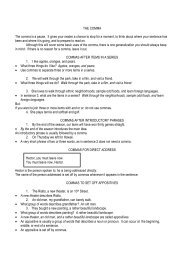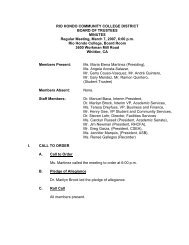Green Building and LEED Core Concepts Guide First Edition
Green Building and LEED Core Concepts Guide First Edition
Green Building and LEED Core Concepts Guide First Edition
Create successful ePaper yourself
Turn your PDF publications into a flip-book with our unique Google optimized e-Paper software.
ENERGY EFFICIENCY<br />
Efforts to reduce energy dem<strong>and</strong> provide the foundation for efforts to use<br />
energy efficiently. This means getting the most productive work from a unit of energy-often<br />
described as a measure of energy intensity. Common metries for buildings <strong>and</strong> neighborhoods include<br />
energy use per square foot <strong>and</strong> use per capita.<br />
<strong>Building</strong>s need to provide efficient space conditioning, water heating, lighting, refrigeration, conveyance<br />
(elevators <strong>and</strong> escalators), <strong>and</strong> safety (see the energy end-use profile developed by the EPA<br />
for a typical office building, represented<br />
in Figure 8). <strong>Green</strong> building<br />
• 1 % - Refrigeration<br />
. l% - Cooking<br />
• 2% - Water Heating<br />
5% - Ventilation<br />
6% - Other<br />
. 17% - L,gh tl ng<br />
• 20% - Office Equipment<br />
• 23% - Cooling<br />
• 25% - Space Heating<br />
emphasizes an integrated approach<br />
to addressing these issues through<br />
whole-building deSign.<br />
For example, green building project<br />
teams can identify opportunities to<br />
improve building envelopes (windows,<br />
walls, <strong>and</strong> roof) in ways thar<br />
enable them to reduce or even eliminate<br />
HVAC systems. This kind of<br />
Figure 8. Energy End Uses in Typical Office <strong>Building</strong> (Source: Data from U.S. EPA <strong>Green</strong><br />
BUilding Workong Group)<br />
integrated design can reduce both<br />
initial capital COSts <strong>and</strong> long-term<br />
operating costs.<br />
Strategies for achieving energy efficiency include the following,<br />
• tdentify passive design opportunities, Use the natural resources of sun <strong>and</strong> wind to heat, cool,<br />
<strong>and</strong>,llluminate a building without add itional energy. Proper building orientation, selection of<br />
materials, <strong>and</strong> location of windows can al low a building to be warm in the winter. stay cool in<br />
the summer, <strong>and</strong> capture daylight.<br />
• Address the envelope. Use the regionally appropriate amount of insulation in the walls <strong>and</strong><br />
roof <strong>and</strong> install high-performance glazing to minimize unwanted heat gain or toss. Make sure<br />
that the building is properly weatherized.<br />
• Install high-performance mechanical systems. Apply life-cyete analysis to the tradeoffs<br />
between capital <strong>and</strong> operating costs, <strong>and</strong> evaluate investments in energy efficiency<br />
technologies accordingly.<br />
• Specify high-efficiency appliances. Computers, monitors, printers, <strong>and</strong> microwave ovens<br />
that meet or exceed ENERGY STAR requirements will reduce plug load dem<strong>and</strong>s (that is,<br />
electrical loads associated with plug-in appliances).<br />
• Use high-efficiency infrastructure. Efficient street lighting <strong>and</strong> LED·based traffic signals will<br />
reduce energy dem<strong>and</strong>s from neighborhood infrastructure.<br />
• Capture efficiencies of scale. Design district heating <strong>and</strong> cooling systems, in which multiple<br />
buildings are part of a single loop.<br />
46<br />
<strong>Green</strong> <strong>Building</strong> <strong>and</strong> <strong>LEED</strong> <strong>Core</strong> <strong>Concepts</strong> <strong>Guide</strong>



